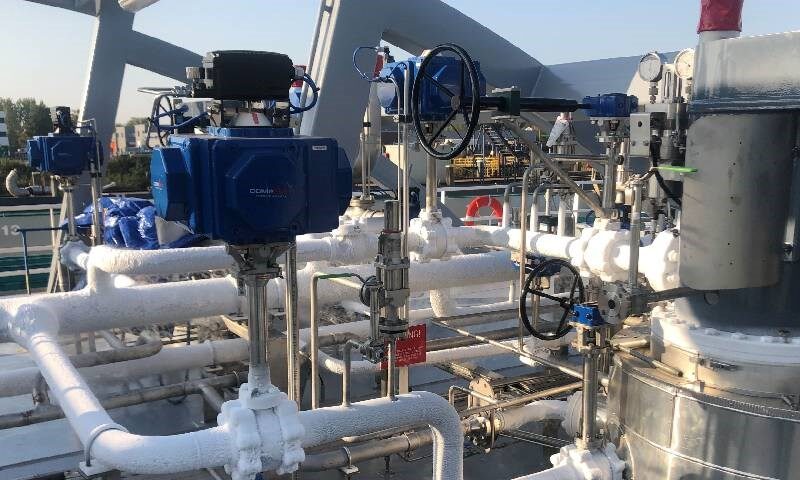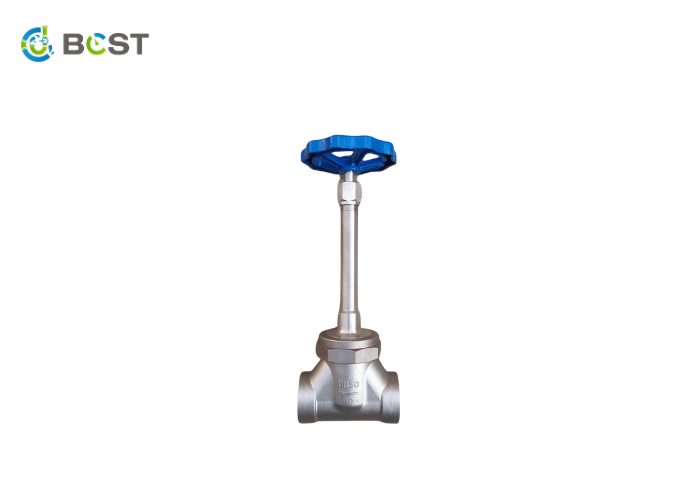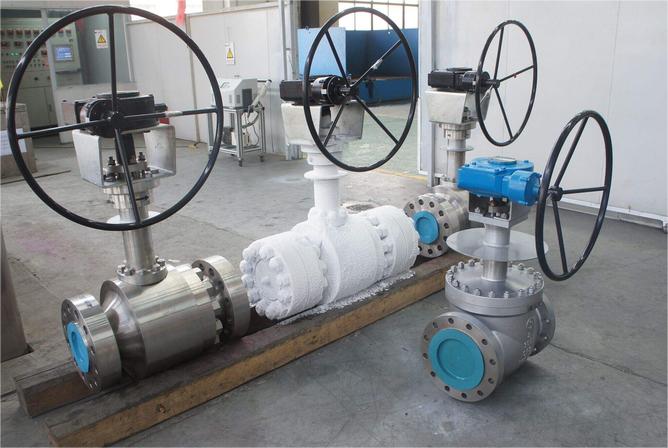
Cryogenics studies low temperatures, their effects on matter, and the methods by which they can be applied to achieve specific goals. Cryogenics includes various techniques, from supercooling liquids with liquid nitrogen to performing cryogenic manipulations such as rapid cooling, slow cooling, or freezing biological materials.
CRYOGENIC VALVES
Cryogenic valves are used to control the flow of fluid through piping. They are often called “cryo” valves because they operate at shallow temperatures below -100°C (-212°F), which allows for greater control over the system’s operation.
They are relatively inexpensive compared to other types. They require no special tools to install. But if in case you are not cautious, they can be hazardous. This is because they can leak liquid nitrogen into the atmosphere and thus pose an inhalation hazard. On the other hand, they can precisely control fluid flow through the pipeline by using a valve sensitive enough to detect small amounts of pressure on its surface. And there are no disadvantages associated with this type of valve if it is used.
ADVANTAGES OF CRYOGENIC VALVES
- Reduced maintenance.
- Reduced installation costs.
- Improved efficiency, energy, and emissions reduction.
- Reduced noise and vibration levels in the compressor room can be a problem for some installations.
DISADVANTAGES OF CRYOGENIC VALVES
- Cryogenic valves are inexpensive.
- Cryogenic valves are not easy to install.
- Cryogenic valves are difficult to maintain.
APPLICATIONS OF CRYOGENIC VALVES
CRYOGENIC VALVES are used in the following applications:
- Compressors
- Air Conditioning System
- Aircraft (including aero engines, airframes, etc.)
- Automotive vehicles (e.g., trucks and buses)
- LNG liquefaction plants
- LNG terminals
- LNG transportation systems
- Food and beverage industries
- Air separation plants
- Steel production plants
- Research laboratories
- Chemical plants
- Petrochemical plants
MATERIALS OF CRYOGENIC VALVES
The materials used to make cryogenic valves are varied. Some are stainless steel, aluminum, brass, and copper or bronze alloy. You can find these materials in various industries such as food processing, chemical manufacturing, metalworking, etc.
The material used depends on the kind of service the valve needs. It should be lead-free if it needs to be resistant to high temperatures. If it has a low-temperature resistance, then aluminum is best. This is because it has good thermal conductivity, whereas other types, such as carbon steel, have a poor thermal conductivity at high temperatures.
HOW CRYOGENIC VALVES ARE INSTALLED IN PIPING
Cryogenic valves are installed in piping at the cryogenic fluid’s entry and exit point. Therefore, we can take the following steps to install a cryogenic valve:
Marking: Marking is done with a marker pen on all sides of the pipe where you want to install your valve. This marking will show you where you need to drill holes for insertion purposes later on in this process. You should also mark any existing fittings or obstructions blocking access to your desired area (such as a wall).
We need to use the right size of the drill bit. We can go for the right drill bit depending on the type of steel used and how many holes are required per inch. Along each side of your chosen component, they will protrude outwards into their respective chambers. It might resemble the enclosure of an outdoor swimming pool or even an underground room under another building in town. People could live above ground but also below ground.
WHY CRYOGENIC VALVES HAVE LONG STEM
The stem of the cryogenic valves is made of stainless steel, which has high corrosion resistance. What this makes it durability and easier to keep up.We can install this valve in any position without fear of it bending or breaking due to its rigidity.
You may wonder why many types of valves are available for cryogenic use. Well, if you’re planning on using your cryogenic system, then knowing how these different types work will be significant because some require more maintenance than others.
HOW CRYOGENIC VALVE WORKS
The cryogenic valve is a mechanical device used in the cryogenic system to transfer liquid nitrogen from the cylinder to the storage tank. It consists of two parts: a spring-loaded piston and a diaphragm. When you pressurize your gas container with liquid nitrogen, it pushes down on this diaphragm, which forces it open like a door into an empty room.
This open door allows more room for more liquid to flow through it; therefore, more space means less pressure—and that’s good news if you want cool things like ice cream or beer!

TYPES OF CRYOGENIC VALVES
CRYOGENIC BALL VALVES
Ball valves are used to control the flow of liquids or gases. By rotating the ball 90 degrees about its axis, fluid can either flow out or be blocked. Even if the valves are not used for a long time, they will provide a reliable seal for the life of the valve because of their long service life. And this is what makes them more popular as globe valves.
Any pipeline and line system for LPG, LNG, thermal fluids, liquid oxygen and nitrogen applications requires the use of a double-sealed ball valve.They can be of reduced and full-bore types. Cryogenic ball valves contain a vapour space of sufficient height which allows vaporisation in the area below the gland. This keeps the gland packing at a temperature close to ambient.
CRYOGENIC ANGLE VALVE
Angle valves can be used with cryogenic fluids (liquid nitrogen) but must be adequately cooled before the operation so that they don’t expand due to temperature changes.
Angle valves are also used in the oil and gas industry to control the flow of fluids. They are also used in mining, chemical, and power industries. Angle valves have many advantages over other valves because they can be easily adjusted by turning a handle on their side. This makes it easy to control the pressure at which fluids move through pipelines or tanks without risking damage from overheating or bursting pipes.
CRYOGENIC GLOBE VALVE
Globe valves are used in various industries, including oil and gas, water treatment, chemical processing, and food packaging. They are also commonly used in cryogenic applications such as scientific research or deep space exploration.
The spherical shape of a globe valve allows it to fit into tight spaces while maintaining the proper flow characteristics. This makes it ideal for applications that require high pressures or low flow rates (such as laboratory equipment). The globe shape also allows you to use smaller valves than other valves, which means fewer maintenance costs.
The Globe valve works like any other valve in your household or applications. It is an outstanding solution for various flows with low-pressure applications such as scientific research or deep space exploration.
CRYOGENIC BUTTERFLY VALVE
Butterfly valves are a type of one-way valve.It consists of two parts, one that opens and another that closes to prevent fluid from flowing out or in.
Butterfly valves can be used as globe or gate valves, depending on their position in the system. The shape also determines whether they are ball and socket or straight cylinder valves with T’s at either end.
The advantage to using butterfly valves is their ability to open quickly and shut off quickly when needed—a necessity if you don’t want your cryogenic liquid depleting too quickly. However, if you need more time between opening/closing operations, this type may not be ideal because it takes longer than other types’ closure rates.
CRYOGENIC GATE VALVE
Gate valves are used where a large flow is required. They have advantages and disadvantages, as well as applications in cryogenic systems.
Gate valves have been used to control the gas discharge rate from a pressure vessel or other closed system by providing an adjustable orifice that allows flow only during specific time intervals. This type of valve has many advantages. For example, it’s easy to assemble, there’s no need for any maintenance after installation, you can easily install it on top of flanges (such as those used with welded joints), and it doesn’t require special tooling other types do.

WHERE ARE CRYOGENIC VALVES USED
Cryogenic valves are used in oil and gas, petrochemicals, and pharmaceuticals. They are also used in cryogenic systems. In addition, You can find cryogenic valves in facilities that require the highest level of reliability for their equipment. These include cryogenics plants and other industrial applications where precision is critical to the success or failure of the operation.
Conclusion
Cryogenic valves are used in the piping industry because they are reliable and sturdy. They can withstand high pressures without breaking or causing damage to the system. They also last longer than traditional valves because they aren’t subject to wear or corrosion like other parts of your plumbing system would be over time due.






